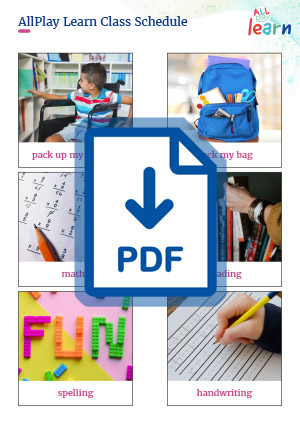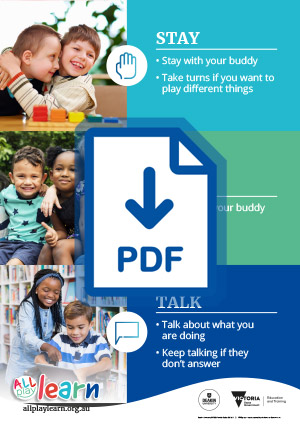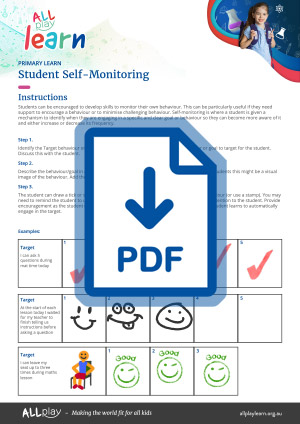
Communication and Language Disorders
On this page:

About communication and language disorders
‘Communication’ is the exchange of both verbal and nonverbal information. It includes talking, as well as the understanding of words, visual information, body language, facial expressions, and gestures (e.g. pointing, waving hello, nodding your head to mean “yes”).
Some students may need support with communication. Each child will have their own profile which may change over development. Some children may have difficulty producing sounds and words (e.g. stuttering or mutism), and they may use visual aspects of communication instead (e.g. gestures, eye contact or picture cards). Other students may find understanding visual communication challenging.
Some students may need support with using and understanding spoken language. A student’s ability to understand spoken language may be different from their ability to use spoken language. For example, a student might be able talk and express themselves clearly, but they may find it harder to understand instructions, especially if they are long or complex.
Some students may require support with using verbal and nonverbal communication in social situations. For example, some students may have trouble understanding the meaning behind greetings (e.g. saying hello, shaking hands) or taking turns in conversations. Other students may not understand humour and jokes, or metaphors.

Strengths
What might be some strengths?
- Some students with communication disorders participate successfully in learning when given clear and specific instructions.
- Some children may have good visual perceptual skills. They may be good at visual searches and recognition.
Where might you provide support?
- Some students may be reluctant to participate in classroom activities and discussions where language is used.
- Some may have difficulties with interacting with other students and making friends.
- Some children may find it hard to express how they feel. This can cause frustration and challenging behaviours.
- Some students may be easily distracted and find it challenging to focus on activities.

Evidence-based strategies
Work Collaboratively
Consider how you give instructions and communicate
Provide feedback
Teach students learning strategies
Create an environment supportive to language development
- Teach students how to create their own learning material. Learning how to take notes and create graphic organisers can help students understand and make connections between main points. For example, students could develop a list of the key concepts and vocabulary items relevant to the curriculum.
- Encourage verbal rehearsal. This can be through repeating information mentally or out aloud.
- Model and prompt language use. Use the student’s interests as an opportunity to model and prompt the use of language in day-to-day scenarios and situations. Aim to model words and sentences several times and with a range of visual stimuli. Encourage the child to repeat the sentence or word as needed.
- Pause and expand. Pause to allow students to initiate a topic which is of interest to them. Ask open-ended questions about this topic. Provide children support to construct and expand on responses.
- When reading stories together, promote the student’s interaction. Have conversations with students about books they read. Ask questions while reading, providing students assistance and scaffolding to respond. For example, consider asking students to predict the emotions and actions of characters, or to retell the content of the story. If appropriate, consider playing with toys which match the theme of the book and include the target vocabulary.
- Be responsive. Follow the lead of children, providing responses immediately. If needed, provide feedback. See Provide feedback.

Best practice tips
Create a safe, supportive, and responsive environment
Set clear rules and expectations
Remove distractions
Consider using slower speech
Be patient
Encourage positive role-models
Consider pairing the student with a buddy
Teach meta-cognitive strategies
Teach social skills
Facilitate the use of AAC systems
Promote self-determination
- Teach children to use mental imagery. Transforming spoken information into visual images can help reduce the burden on their working memory, and help them understand and remember discourse better.
- Building the social skills of children can facilitate their communicative participation. For example, you might teach children to consider other people’s feelings, be kind, and share. Similarly, teaching children conversational skills, such as asking questions and sharing important information, can facilitate their social interaction with others.
- Unaided AAC systems (e.g., signing, vocalisation, facial expressions) and low-tech AAC systems (e.g., picture communication boards and books, visual schedules) can be beneficial in helping children express themselves. Make sure that the environment is arranged to facilitate children's communication with these systems. For example, check that the AAC system is placed where children can see and access. Add key vocabulary to their AAC system specific to your curriculum (where appropriate). For example, vocabulary related to a new topic could be introduced. You might also consider additional training on using the relevant AAC systems and collaboration with other professionals and families.
- Promote self-determination. Empower and teach children to make simple choices, set goals, be independent, and develop problem-solving abilities. Use technology as needed. For example, technology can be used by students to indicate preference.

Curriculum considerations

Other considerations

Relevant resources
Visit our resources page for a range of resources that can help to create inclusive education environments for children with disabilities and developmental challenges. Some particularly relevant resources for children with communication disorders include:








